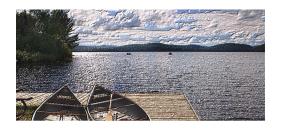Quick links to procedures on this page:
You can add texture to an image by using the luminance of a clone source or a pattern. The method uses the light and dark areas in the clone source or pattern to produce the illusion of dents and bumps. To experiment with different looks, you can change the clone source or pattern.

The clone source luminance helps produce a textured effect.
Any image effects or brushstrokes that you apply to the clone source result in different textures. For example, you can create raised areas in the clone by darkening the area in the source image.
|
• |
To use a clone source, choose Window  Clone Source. In the Clone Source panel, click the Open Image button Clone Source. In the Clone Source panel, click the Open Image button  , and Open Source to choose a clone source. , and Open Source to choose a clone source. |
|
• |
To use a pattern, choose Window  Media Library Panels Media Library Panels  Patterns, and click a pattern swatch from the Pattern library panel. Patterns, and click a pattern swatch from the Pattern library panel. |
|
4
|
Choose Effects  Surface Control Surface Control  Apply Surface Texture. Apply Surface Texture. |
|
5
|
Choose Original Luminance from the Using list box. |
|
6
|
Adjust the Softness slider to control the amount of distortion created by the texture. |
|
7
|
In the Appearance of Depth area, adjust any of the following sliders: |
|
• |
Amount — controls how much surface texture is applied to the image. Moving the slider all the way to the right applies the maximum amount. |
|
• |
Picture — controls how much of the color from the original image is applied to the texture. At 100%, the full color of the picture shines through. Moving the slider to the left displays more black, leaving only the shine. |
|
• |
Shine — controls how much highlight appears on the surface of the texture. Higher Shine values make the texture look metallic. |
|
• |
Reflection — maps a clone source image or pattern onto the texture at a variable percentage |
|
8
|
In the Light Controls area, adjust any of the following sliders: |
|
• |
Exposure — adjusts the overall lighting amount from darkest to brightest |
Copyright 2013 Corel Corporation. All rights reserved.
